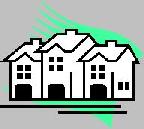
 |
|
| Home Terms | |
| Single-family home |
|
Information about home, mortgage, insurance, homebuyer, real estate, property, buy home, home insurance, financing, home financing, home buyer, first time homebuyer, homes, homebuying, credit, condo.
Main Page: homebuyer, home insurance, first time homebuyer, homes, homebuying, home financing, property, insurance, real estate, |
Definition of Single-family home
Single-family homeA detached house.
Related Terms:Home EquityThe difference between the price for which a home could be sold (market value) and the total debts registered against it. Coach homeOne of a group of homes in a two-story building, with own garage and entrance. Courtyard homeA home with a courtyard as its main entrance. Home warrantyLike any other warranty, this guarantees the property against failure of mechanical systems, such as plumbing, electrical, heating and installed appliances. Patio homeSmall, single-family home with a patio. Stick-Built HomeA house built without prefabricated parts. Also called conventional building. Equity-based insuranceLife insurance or annuity product in which the cash value and benefit level fluctuate according to the performance of an equity portfolio.  Equity investmentThrough equity investment, investors gain part ownership of the corporation. The primary type of equity investment is corporate stock. EquityThe interest of the owner in a property over and above all claims against the property. It is usually the difference between the market value of the property and any outstanding encumbrances. EquityThe value of a homeowner's unencumbered interest in real estate. equity is the difference between the home's fair market value and the unpaid balance of the mortgage and any outstanding liens. equity increases as the mortgage is paid down or as the property appreciates. Cash Surrender ValueThis is the amount available to the owner of a life insurance policy upon voluntary termination of the policy before it becomes payable by the death of the life insured. This does not apply to term insurance but only to those policies which have reduced paid up values and cash surrender values. A cash surrender in lieu of death benefit usually has tax implications. Contingent OwnerThis is the person designated to become the new owner of a life insurance policy if the original owner dies before the life insured. Fiat MoneyFiat MOney is paper currency made legal tender by law or fiat. It is not backed by gold or silver and is not necessarily redeemable in coin. This practice has had widespread use for about the last 70 years. If governments produce too much of it, there is a loss of confidence. Even so, governments print it routinely when they need it. The value of fiat mOney is dependent upon the performance of the economy of the country which issued it. Canada's currency falls into this category. Group Life InsuranceThis is a very common form of life insurance which is found in employee benefit plans and bank mortgage insurance. In employee benefit plans the form of this insurance is usually One year renewable term insurance. The cost of this coverage is based on the average age of everyOne in the group. Therefore a group of young people would have inexpensive rates and an older group would have more expensive rates. Money LaunderingThis is the process by which "dirty mOney" generated by criminal activities is converted through legitimate businesses into assets that cannot be easily traced back to their illegal origins. OwnerThis is the person who owns the insurance policy. It is usually the same person as the insured but it could be someOne else who has the permission of the insured to be the owner, like a spouse, a common-law-spouse, an offspring, a parent, a corporation with insurable interest or a business partner with insurable interest. In order for someOne else to be an owner of your policy, they have to have a legitimate insurable interest in you.  Registered Pension PlanCommonly referred to as an RPP this is a tax sheltered employee group plan approved by Federal and Provincial governments allowing employees to have deductions made directly from their wages by their employer with a resulting reduction of income taxes at source. These plans are easy to implement but difficult to dissolve should the group have a change of heart. Employer contributions are usually a percentage of the employee's salary, typically from 3% to 5%, with a maximum of the lessor of 20% or $3,500 per annum. The employee has the same right of contribution. Vesting is generally set at 2 years, which means that the employee has right of ownership of both his/her and his/her employers contributions to the plan after 2 years. It also means that all contributions are locked in after 2 years and cannot be cashed in for use by the employee in a low income year. Should the employee change jobs, these funds can only be transferred to the RPP of a new employer or the funds can be transferred to an individual RRSP (or any number of RRSPs) but in either scenario, the funds are locked in and cannot be accessed until at least age 60. The only choices available to access locked in RPP funds after age 60 are the conversion to a Life Income Fund or a Unisex Annuity. Registered Retirement Savings Plan (Canada)Commonly referred to as an RRSP, this is a tax sheltered and tax deferred savings plan recognized by the Federal and Provincial tax authorities, whereby deposits are fully tax deductable in the year of deposit and fully taxable in the year of receipt. The ability to defer taxes on RRSP earnings allows One to save much faster than is ordinarily possible. The new rules which apply to RRSP's are that the holder of such a plan must convert it into income by the end of the year in which the holder turns age 69. The choices for conversion are to simply cash it in an pay full tax in the year of receipt, convert it to a RRIF and take a varying stream of income, paying tax on the amount received annually until the income is exhausted, or converting it into an annuity with guaranteed payments for a chosen number of years, again paying tax each year on mOneys received. Registered Retirement Income Fund (Canada)Commonly referred to as a RRIF, this is One of the options available to RRSP holders to convert their tax sheltered savings into taxable income. Spousal Registered Retirement Savings PlanThis is an RRSP owned by the spouse of the person contributing to it. The contributor can direct up to 100% of eligible RRSP deposits into a spousal RRSP each and every year. Contributing to a spouses RRSP reduces the amount One can contribute to One's own RRSP, however, if the spouse is a lower income earner, it is an excellent way in which to split income for lower taxation in retirement years. Account ValueThe sum of all the interest options in your policy, including interest. Accumulated ValueAn amount of mOney invested plus the interest earned on that mOney. Benefit ValueThe amount of cash payable on a benefit. Cash Surrender ValueBenefit that entitles a policy owner to an amount of mOney upon cancellation of a policy. PolicyownerThe person who owns and holds all rights under the policy, including the power to name and change beneficiaries, make a policy loan, assign the policy to a financial institution as collateral for a loan, withdraw funds or surrender the policy. Appraisal ValueAn estimate of the market value of the property. Deed (Certificate of Ownership)The document signed by the seller transferring ownership of the home to the purchaser. This document is then registered against the title to the property as evidence of the purchaser's ownership of the property.  Gross Household IncomeGross household income is the total salary, wages, commissions and other assured income, before deductions, by all household members who are co-applicants for the mortgage. Total Debt Service (TDS) RatioThe percentage of gross income needed to cover monthly payments for housing and all other debts and financing obligations. The total should generally not exceed 37% of gross monthly income. Assessed valueThe dollar value of an asset assigned by a public tax assessor for the purposes of taxation. Courtyard homeA home with a courtyard as its main entrance. Earnest moneyA deposit made by potential home buyers during negotiations with the seller. The sum shows a seller that a buyer is serious about purchasing the property. The mOney usually is counted toward the down payment. Home warrantyLike any other warranty, this guarantees the property against failure of mechanical systems, such as plumbing, electrical, heating and installed appliances. Patio homeSmall, single-family home with a patio. TownhouseOne of a row of houses connected with common side walls. Building CodeA comprehensive set of laws that controls the construction or remodeling of a home or other structure. ClerestoryAn outside wall of a room or building that rises above an adjoining roof and contains windows. Crown MoldingA molding used on cornice or wherever an interior angle is to be covered, especially at the roof and wall corner. DuctworkA system of large tubes, pipes or channels (ducts) designed to deliver air to and from a furnace or other air-handling unit. R ValueA measure of insulation. A measure of a material's resistance to the passage of heat. The higher the R value, the more insulating "power" it has. For example, typical new home's walls are usually insulated with 4" of batt insulation with an R value of R-13, and a ceiling insulation of R-30. Stick-Built HomeA house built without prefabricated parts. Also called conventional building. ZoneThe section of a building that is served by One heating or cooling loop because it has noticeably distinct heating or cooling needs. Also, the section of property that will be watered from a lawn sprinkler system. Zone ValveA device, usually placed near the heater or cooler, which controls the flow of water or steam to parts of the building; it is controlled by a zOne thermostat. Related to : home, mortgage, insurance, homebuyer, real estate, property, buy home, home insurance, financing, home financing, home buyer, first time homebuyer, homes, homebuying, credit, condo. |